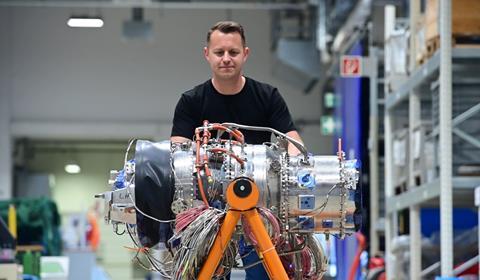In early June, Rolls-Royce celebrated the 30th anniversary of its site in Dahlewitz near Berlin. What began as a joint venture with BMW in the early 1990s and an investment of 30 million Deutschmarks – then about $18 million – has grown into a key part of the company’s industrial footprint that will in 2023 build upwards of 250 engines for business jet applications.
But the facility’s importance to Rolls-Royce stretches beyond just making engines for private jets: Dahlewitz has a central role in the company’s research and innovation activities as it prepares for the next generation of propulsion systems (and thanks to the disruption of Brexit, it also holds the type certificates for the entire Trent family of widebody powerplants).
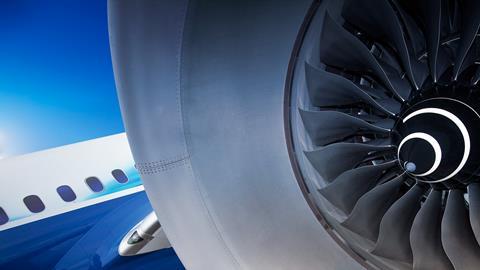
If you look closely enough, the plant also bears testament to Rolls-Royce’s fluctuating fortunes and industrial strategy: an assembly line for the International Aero Engines V2500 went first – R-R in 2012 having relinquished its share in the programme, and any interest in the narrowbody market – to be followed in 2020 by a Trent XWB-84 line, a victim of the Covid-19 pandemic’s impact on widebody demand.
The not unreasonable decision to centralise Trent XWB-84 production in Derby was taken by former chief executive Warren East during one of the several bouts of restructuring that took place during his tenure. But now East has gone, replaced by Tufan Erginbilgic, who marked the start of his reign by declaring that Rolls-Royce was a “burning platform” that had one last chance to get its house in order.
Erginbilgic is in the process of defining, if not another restructure exactly, then at least a reshaping of the business. His transformation plan is due to be presented later this year but there has already been management churn: the civil aerospace unit has a new president, with Rob Watson moving across from the same post at Rolls-Royce Electrical; there his role has been taken by Olaf Otto; and in defence, Adam Riddle has replaced Tom Bell as president.
Back in Dahlewitz, the 30-year milestone was marked at a special event held at the factory on 9 June. Against the backdrop of a Trent XWB, Dr Dirk Geisinger, chief executive of Rolls-Royce Deutschland, praised the development of the site: “It is not a fairy story – it’s reality; a beautiful story written by life,” he says.
Geisinger remembers that early business plans foresaw the operation expanding to around 600 people – 30 years later it has more than 2,500 employees and has built over 8,500 engines which have accumulated in excess of 30 million flying hours.
These days, Dahlewitz is best known as Rolls-Royce’s centre of excellence for business jet engines. As Geisinger puts it “we are proud to be the market leader in the top-end segment of business aviation”. What he means is that the site’s current products – the BR710, BR725 and the three-strong Pearl family – equip some of the longest-range private jets available.
That includes the Bombardier Global 5000 and 6000 – powered by the BR710 – and the Pearl 15-equipped Global 5500 and 6500.
Watson too was present at the event, outlining his pride “to work for an organisation that 30 years ago had the vision to commit to the future” which delivered “the capability we have today”.
Although barely two months into his new role, he is clear about Rolls-Royce’s immediate strategy in commercial engines: its three focus areas are “availability, efficiency and reliability”, he says.
In part that is an attempt to draw a line under the severe durability problems seen pre-pandemic by operators of Trent 1000-equipped Boeing 787s that, at its height, saw around 50 jets taken out of service.
“We are really pleased with how the [Trent 1000] is doing,” says Watson. “It has had its problems earlier in its life, but it has largely recovered.”
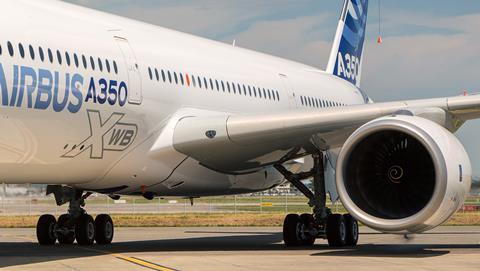
There are still “a couple of upgrades we need to deliver into this engine,” he admits, with those already having been implemented to the derivative Trent 7000 for the Airbus A330neo, which have “doubled the time on wing”, says Watson.
“That modification we have just taken through certification with the [US regulator] and we’ll roll that in to the Trent 1000 towards the end of this year.
“In the next 18 months we’ll have those engines back where customers would expect that engine to be performing,” says Watson.
The Trent 1000 holds a claimed 30% market share on the 787 against the GE Aerospace GEnx “and we are looking to protect that and grow that where we can”, he adds.
But the star of the show as far as Watson is concerned is the Trent XWB on the A350, which is “really powering the future of the business”. Two variants of the widebody engine are in production – the XWB-84 for the -900 and the XWB-97 for the -1000, respectively delivering 84,000lb and 97,000lb of thrust – providing “really good reliability and great efficiency”.
Future improvements, particularly around durability, are being considered, with technologies matured on the UltraFan demonstrator, particularly high-temperature materials, the most likely to be incorporated.
Although the UltraFan engine is often thought of as a powerplant in search of a platform, Watson suggests it offers more than that. “Actually from a Rolls-Royce perspective, when I talk about all these durability improvements that we make to our engines, a lot of it is driven by the technology on UltraFan today,” he says.
Having run for the first time on 24 April, the UltraFan technology demonstrator had by early June been taken to around 60% power, says Simon Burr, director of product development and technology, “and we are incrementing up”.
Testing has proceeded at a steady but considered pace, says Burr, pointing to the size of the engine – with its 140in (355cm) fan, it is the largest ever jet engine – the infancy of the testbed, and that it is a “completely novel engine”.
In fact, it is the first time in 54 years and the development of the RB211 that Rolls-Royce has tested a new engine architecture. “It’s a big change because you’re calibrated on how a three-shaft engine works and you have to build up your knowledge of how an [new] engine will behave differently,” Burr says.
Incorporating a suite of new technologies – including carbon-titanium fan blades, Advance3 core, a new combustor, a high-power gearbox – the UltraFan should deliver a 10% fuel-burn improvement over manufacturer’s newest engine, the Trent XWB, or 25% over earlier Trent models.
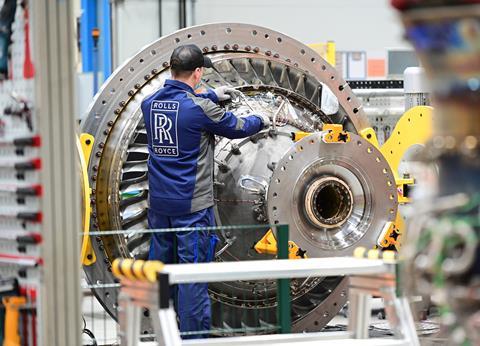
In the longer term, the propulsion specialist sees the “scalable” architecture – covering the 25,000-100,000lb (111-444kN)-thrust range – as suitable for future single- or twin-aisle applications likely to emerge in the 2030s. The demonstrator engine has a bypass ratio of around 15:1 and is sized to produce 80,000lb of thrust.
Initial evaluations have included operability tests – looking at the dynamic response of the engine and how its large fan and gearbox affect inertia and response to throttle movement – alongside tweaks to its operation, such as to optimize performance.
“We are working through those now before we get to full power,” says Burr, while admitting he is “very, very happy” with progress to date.
Test activities will be paused during the summer for updates to Testbed 80, notably the installation of a dynamic X-ray capability.
By far the biggest change between the UltraFan and its predecessors is the use of a gearbox, marking a complete change of architecture for Rolls-Royce compared with its ubiquitous three-spool design.
Rolls-Royce has selected a planetary arrangement for the component, against the star-gear layout seen in Pratt & Whitney’s geared-turbofan narrowbody engines. This, says Burr, enables the higher bypass ratios necessary for future engine designs.
Built in conjunction with Liebherr Aerospace, the gearbox has been designed to handle loads of 51MW and “we have run it well into the 60s”, says Burr.
Tests of multiple gearboxes have focused not only on the component itself “but the design parameters that enable us to scale”, says Burr.
“If you start large, you can scale down and we are doing studies across the range, particularly on the bearing design.” Burr stresses that, at this stage, there are no plans to build lower-power gearboxes for test purposes.
“We have an ongoing research programme on scaling the technology. So we’ll see. You have to think about where you spend your money,” he says.
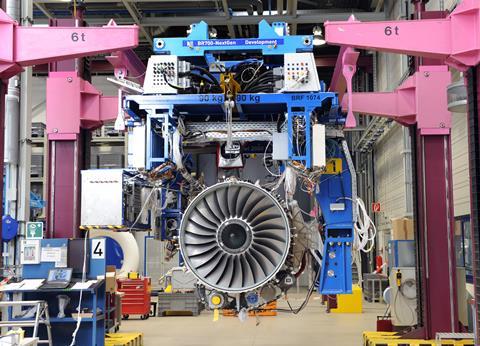
“What you want to do is be ready when someone says ‘Well, can you build something that’s smaller?’. We are not going to build things and just put them on the shelf. These are very, very expensive investments.”
While it is easy to perceive UltraFan as a UK-only project, Dahlewitz has played a key role in its development. Employment of two rigs – one for attitude, one for power – inside the site’s Mechanical Test Operations Centre enabled maturation of the component prior to its assembly with the rest of the UltraFan engine. The attitude rig has since been modified to test a new small gas turbine being developed by Rolls-Royce as part of a turbogenerator system.
Mind you, Dalhewitz was not always the high-tech hub seen today. Back in the early 1990s, it was an unremarkable piece of what, until recently, had been East Germany. The wall might have come down in 1989, followed by reunification with its western neighbour a year later, but significant change was yet to touch this corner of the state of Brandenburg.
Heavily agricultural and “sparsely populated”, according to Dietmar Woidke, the region’s current minister president; living there was “dreamlike” – in the sense of it being lost – he remembers, which “proved to be a burden” on its economic development.
Post-dissolution of the German Democratic Republic, unemployment soared: from 15% initially to 18.7% by 1994. And shorn of the surety provided by the Communist state, people felt an “existential fear”, he says.
Despite the proximity to Berlin and to Schonefeld airport, growth proved hard to stimulate. There was, says Woidke, “plenty of land” but “a lack of investors courageous enough to invest in the region”.
But then there were: in 1990 Rolls-Royce and automotive manufacturer BMW announced a joint venture that would establish a new engine production plant in Dahlewitz.
Rolf Neuman, an adviser to Rolls-Royce at the time and later a regional director, says the propulsion specialist had ambitions to invest in the former East Germany but was unsure where to locate the factory. In the end, he says, a “need for skilled labour” drove it to Dahlewitz: the nearby maintenance base of ex-flag carrier Interflug provided a ready pool of qualified aerospace engineers.
Built on a greenfield site – grazing land owned by a collective farm – the facility opened in 1993, initially manufacturing BR700-series business jet engines. Although BMW stepped away from the venture in 1999, the plant has continued to thrive.
“We were able to plant something in that green field which had a major impact on the development of this state,” adds Woidke.
“We transformed Maerkischer sand”, he says, referring to the region’s sandy soil “into fertile land.”
